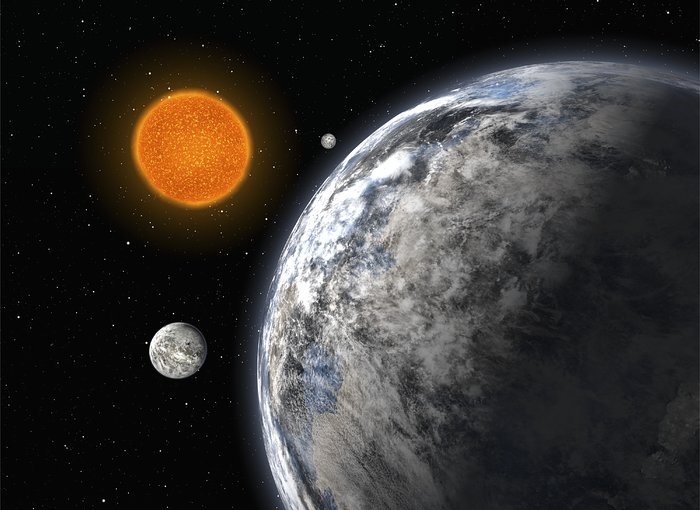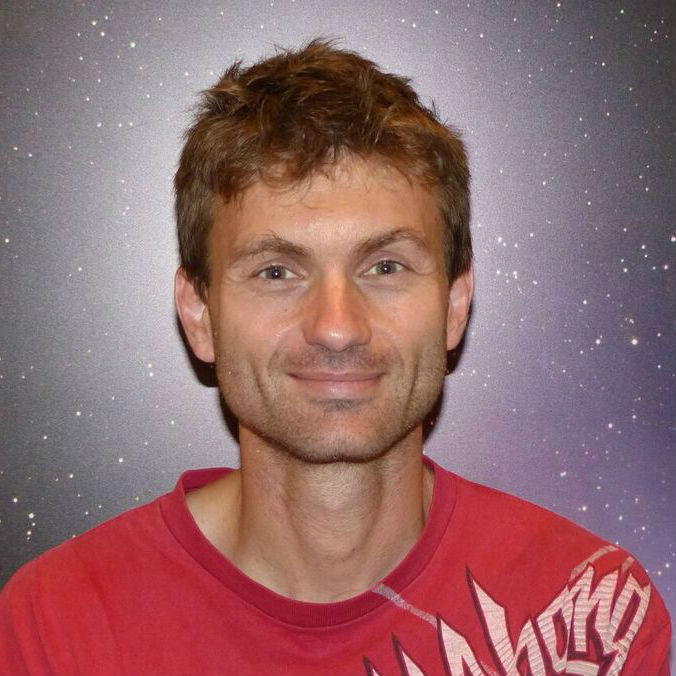Domain 3: Atmospheres, surfaces, and interiors

Credit: ESO
The atmosphere of an exoplanet is a unique window to probe its chemistry, possibly its surface and interior conditions, and ultimately its potential for habitability (Seager 2014). In a complementary way, solar system planets and moons offer opportunities for learning about atmospheres, surfaces and interiors through probes and in-situ data. In the past several years, the study of exoplanetary atmospheres has come of age both on the observational and theoretical fronts (for reviews, see Burrows 2014, Heng & Showman 2015, and Deming & Seager 2017). It is firmly being established as a field of inquiry in its own right (Seager 2010; Heng 2017), distinct from the study of planetary atmospheres in the Solar System, while borrowing from and generalising the techniques of Earth and planetary scientists.
At the forefront of research on exoplanetary atmospheres is the use of current and next-generation facilities, both from space and from the ground, to detect and identify constituent atoms and molecules. The use of the HST (Hubble Space Telescope) and SST (Spitzer Space Telescope) to measure transmission spectra has matured (e.g., Sing et al. 2016), including the use of ultraviolet data to study the escape of the atmosphere from the gravitational well of the exoplanet (Ehrenreich et al. 2015). From the ground, the technique of using high-resolution spectroscopy has been honed to the point where the data quality rivals that of data obtained using the Hubble Space Telescope (Snellen et al. 2010; Wyttenbach et al. 2015). These observational efforts are matched by theoretical efforts to improve our interpretational techniques (e.g., Heng 2016) and advance our understanding of the physical and chemical mechanisms at work in these atmospheres (e.g., Guillot 2010; Madhusudhan 2012; Grimm & Heng 2015; Drummond et al. 2016). There have also been attempts to link the atmospheric composition to the formation history of the exoplanet (Oberg et al. 2011; Madhusudhan et al. 2014; Oberg & Bergin 2016, Mordasini et al. 2016). In parallel, attention has turned to scrutinising small, ultra-cool stars, which are the diminutive cousins of our Sun, for finding rocky exoplanets that are amenable to atmospheric characterisation (Gillon et al. 2016), including the SAINT-EX project led by Prof. Brice-Olivier Demory (SNF Professorship).
Switzerland developed strengths in the theoretical, observational and instrumentation-related aspects of atmospheres, surfaces and interiors. Domain 3 unifies, strengthens and innovates upon these strengths and activities, and makes a link with the Solar System. One of our goals is to develop within the NCCR the competences necessary to compete on the international stage in terms of procuring telescope time, securing membership on instrument-related consortia, and contributing to cutting-edge advancements in theoretical and observational techniques. Ultimately, the study of exoplanetary atmospheres and climates is geared towards the search for bio-signatures (e.g., Seager et al. 2013), an aspect we address in our bonus programme on habitability.
The research in Domain 3 will combine high-resolution spectroscopy of exoplanetary atmospheres, obtained either by direct imaging or transits, with theoretical models to interpret the data and translate them into constraints on atmospheric chemistry, temperature structure, and possibly even atmospheric escape. The long-term evolution of the atmosphere and its interaction with the interior will be studied by means of numerical modelling with solar system bodies to provide detailed benchmarks. Telltale signs of life, i.e., bio-signatures, will be sought for in the atmospheres of exoplanets using the same state-of-the-art observation techniques and theoretical models, while Mars will provide the Solar System perspective on such signatures. Finally, a virtual laboratory of exoplanetary atmospheres will be developed and used to place bio-signatures into the context of their environments.
Domain 3 includes externally funded projects.
Project 3.1: Theory and simulation of exoplanetary atmospheresProject leader: Kevin Heng (UBE)
More information
More information is available on our dedicated website.
Team
Associate
Project 3.2: Exoplanet atmospheres at high spectral resolution
Project leader: Christophe Lovis (UGE)
More information
More information is available on our dedicated website.
Team
Associate
Project 3.3: Direct imaging and spectral characterisation of ultra-cool companions to nearby stars
Project leader: Damien Ségransan (UGE)
More information
More information is available on our dedicated website.
Team
Project 3.4: Remote-sensing of primitive objects and potential habitats in our and other solar systemsProject leader: Nicolas Thomas (UBE)
More information
More information is available on our dedicated website.
Team
Project 3.5: Search And characterIsatioN of Transiting EXoplanets (SAINT-EX)
Project leader: Brice-Olivier Demory (UBE)
This project is funded through Prof. Brice-Olivier Demory’s SNF Professorship (PP00P2_163967), independently from the NCCR PlanetS.
Links with other PlanetS projects
Project 3.5 shares a postdoc position with Project 3.1 (100% NCCR funded through Project 3.1) about the characterisation of exoplanets using phase-curve photometry with the upcoming JWST and the ESA small class mission CHEOPS.
More information
More information is available on our dedicated website.
Team
Project 3.6: Future of upper atmospheric characterisation of exoplanets with spectroscopy (FOUR ACES)
Project leader: David Ehrenreich (UGE)
Links with other NCCR projects
Project 3.6 is linked with the following projects within PlanetS: Project 3.1 (WP1) and Project 3.2 (WP1) for the development of ground-based high-resolution spectroscopy of exoplanetary atmospheres (shared postdoctoral position 100% NCCR funded through projects 3.1 and 3.2).
More information
More information is available on our dedicated website.
Project 3.7: PlanetsInTime: the history of planets from their origins to present day
Project leader: Christoph Mordasini (UBE)
Links with other NCCR projects
Project 3.7 is linked with the following projects within PlanetS: Project 3.7 will work together with Project 3.1 (WP2) on the project Bern Exoplanet Tracks and comparison with observations (BEX). In this project, a self-consistent coupling is made of the atmospheric models developed in Project 3.1 with planet evolution models. The results will be compared with observations from Project 3.3. It will be developed by a NCCR PhD funded through Project 3.1 and working shared between the PlanetsInTime team (Project 3.7), Project 3.1, and Project 3.3.
More information
More information is available on our dedicated website.
Team
Associate
Associate
Project 3.8: The climates and habitability of small exoplanets around red stars (EXOKLEIN)
Project leader: Kevin Heng (UBE)
Links with other NCCR projects
This project is linked with project 3.1
More information
More information is available on our dedicated website.
Team
Project 3.9: SpectroPhotometric Inquiry of Close-in Exoplanets around the Desert to Understand their Nature and Evolution)
Project leader: V. Bourrier, UGE
More information
More information is available on our dedicated website.
Team
Associate
Associate
Project 3.10: Time variability as a new window on exoplanet climates) Project leader: M. Lendl, UGE
More information
More information is available on our dedicated website.
Team
Associate
Associate
Domain 3 Day
An online Domain 3 Day took place on 14 January 2021. A recording of the talks given by members of all projects is available here.

























